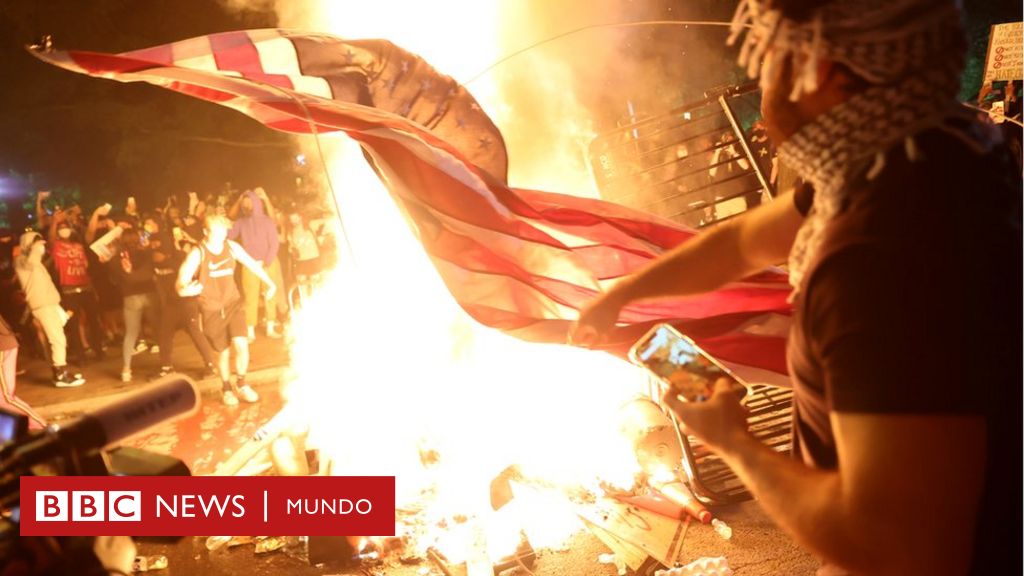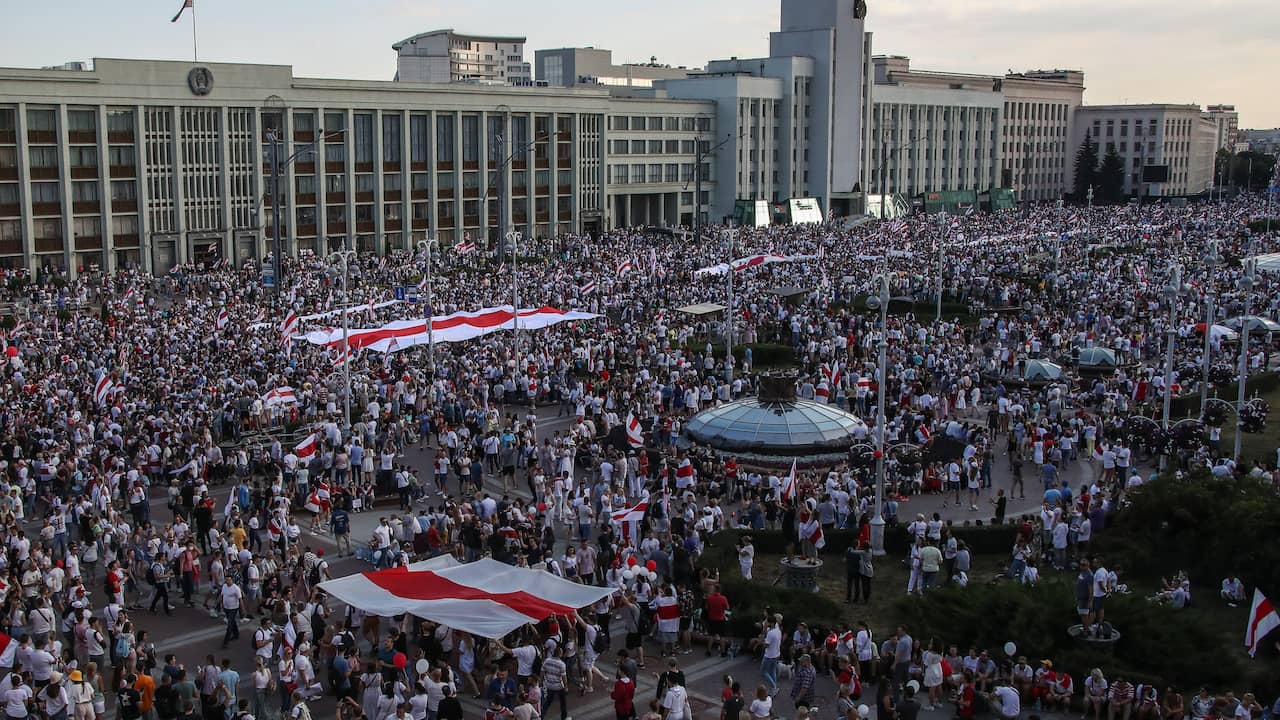Image copyright
Reuters
The protests have already spread to more than 75 cities.
For the sixth day in a row, protests, curfews, looting and anger shake the United States. From one extreme to another: from New York to Los Angeles, from Florida to Seattle, and even near the White House.
The demonstrations, which initially began in Minneapolis after George Floyd, a 46-year-old African-American, died after a police officer pressed his knee against his neck for more than 8 minutes, have spread across more than 75 cities in allor the country.
For nearly a week, marches protesting police brutality against African Americans have continued to turn into clashes with the police, burning of cars and violence.
- Who was George Floyd, the African-American killed in police custody in Minneapolis (and what is known about the officer involved in the incident)
- Grief and anger shake some 50 US cities after George Floyd’s death in police custody
To try to contain the situation, local authorities decreed curfews in more than 40 cities and in 15 states they deployed the National Guard, the military reserve force that the US uses for emergency situations.
Image copyright
Reuters
Violent protests were reported near the White House.
As Darnell Hunt, professor of sociology and African American studies at the University of California, Los Angeles, told the BBC, this week’s riots in the United States are the most serious reported in the country since 1968, when Martin Luther King Jr. was assassinated.
And, in his opinion, the way in which the police have responded with an “increase in their aggressiveness” may lead to worsening the situation.
“Deploying the National Guard, using rubber bullets, tear gas and pepper spray, these are a variety of police tactics that can exacerbate an already tense situation,” he said.
The demonstrations of thousands of people take place a few days after the US began to reopen after being hit by the coronavirus pandemic, which has left more than 100,000 dead there and while social distancing rules remain in force.
These are some of the latest news:
- Trump told governors in a video conference Monday that “if they don’t prevail, they will be wasting their time” and that “they are going to run over them, they are going to look like a bunch of idiots.” The White House said his words are taken out of context.
- At least 75 cities protests were registered in the United States, in many cases resulting in clashes with the police and vandalism.
- Some 40 cities decreed curfews, but the demonstrations continued.
- Trump, who attributes the riots to the “radical left”, announced that he will designate the movement “Antifa“as a” terrorist group “.
- US media reported Sunday that Trump was rushed to a bunker, before the proximity of the protesters to the White House.
- An attorney for Floyd’s family charged the police officer who put a knee on his neck with “premeditated murder.”
- The protests spread to several cities outside the US on Sunday including Berlin, Toronto and London, where about 20 people were arrested.
What happened at the protests on Sunday?
Image copyright
Getty Images
Stores were looted in Philadelphia, Pennsylvania, and in several other cities around the country.
- 12 violent deaths of African-Americans that sparked waves of outrage in America before George Floyd
In Washington DC, protesters put the Secret Service, in charge of Trump’s security, on alert again and clashes with the police were recorded, who fired tear gas.
In the capital district, altercations and fires were also reported in a park and a church closethe to the White House, which already had to be closed in an emergency on Friday.
For the second day in a row, thousands of people took to the streets in Florida and in the city of Miami, what began as a peaceful protest turned into chaos after protesters smashed glass and police responded with smoke bombs.
What began as a peaceful protest near the Santa Monica Pier in Los Angeles ended in clashes between protesters and police. Looting was also reported in stores of popular brands such as Vans, Gap and Nike, as well as in shopping centers and other outlets.
More than 80 people were detained in Detroit, where there were also reports of shootings and altercations between protesters and police, while in Birmingham, Alabama, protesters began tearing down a Confederate monument.
In New York, where a hundred detainees were reported, protesters marched across the Brooklyn and Williamsburg bridges, and stopped traffic on the Manhattan Bridge.
Image copyright
Getty Images
The National Guard has been deployed to dozens of states.
In Philadelphia, there were also new looting and burning of police cars, while in Seattle dozens of cars were burned and several shops were looted.
In Salt Lake City, a man pointed a bow and arrow at protesters and was attacked by the crowd, the Reuters news agency reported.
Following mounting protests in Arizona, the governor declared a state of emergency and imposed a curfew “effective for one week.”
Image copyright
AFP
The peaceful protests turned violent throughout the day.
In Chicago a massive protest during the day ended in vandalism during the night and large supermarket chains such as Walmart and Target were looted.
Analysis by Anthony Zurcher, BBC journalist in Washington
For more than three years, Donald Trump has ruled a nation of relative peace and prosperity.
The crises he has had so far were largely of his own making and he faced them by rallying his supporters and condemning his opponents.
Now Trump faces an inappropriate situation for a divisive playbook.
The American economy has been hit by a deadly pandemic, and the death of George Floyd at the hands of a Minneapolis police officer has spread race riots across the country.
People now live moments of uncertainty, they are afraid and they are increasingly angry.
These are circumstances that would test the abilities of even the most skilled leaders. This president, however, runs the risk of getting lost at sea.
His public calls for unity have been undermined by a penchant for insults and bellicosity on Twitter. Discipline when it comes to messages, a valuable attribute at this time, is not his strong suit.
There may be no easy way to guide the nation through its present danger.
What are the protests due to?
The protests, which take place for the sixth consecutive day and to which new cities have been added, were unleashed after a video was released in which the black man is seen with breathing difficulties on the floor, while a white policeman presses him on the neck with knee.
Police officers approached Floyd because they suspected he had used a counterfeit $ 20 bill.
Being immobilized with his knee on his neck, the man tries to call for help and repeatedly yells “I can’t breathe” or “I’m going to die.”
Image copyright
DARNELLA FRAZIER
The 44-year-old white officer pinning Floyd in the video has been identified as Derek Chauvin.
Later, he appears immobile in the images, before being placed on a stretcher and transported in an ambulance.
- What is the “Minnesota Paradox” and what does it say about racial profiling in the United States?
Derek Chauvin, the police officer pictured, was arrested Friday for his alleged connection to the victim’s death and three other Minneapolis Police Department (MPD) officials were fired. The FBI joined the investigation of the events.
The protesters denounce that Floyd’s death is a act of racial discrimination and they demand that measures be taken to prevent such events from being repeated and that the other three agents who were present during the event be brought to justice.
Now you can receive notifications from BBC Mundo. Download the new version of our app and activate them so you don’t miss out on our best content.
- Do you already know our YouTube channel? Subscribe!
–


